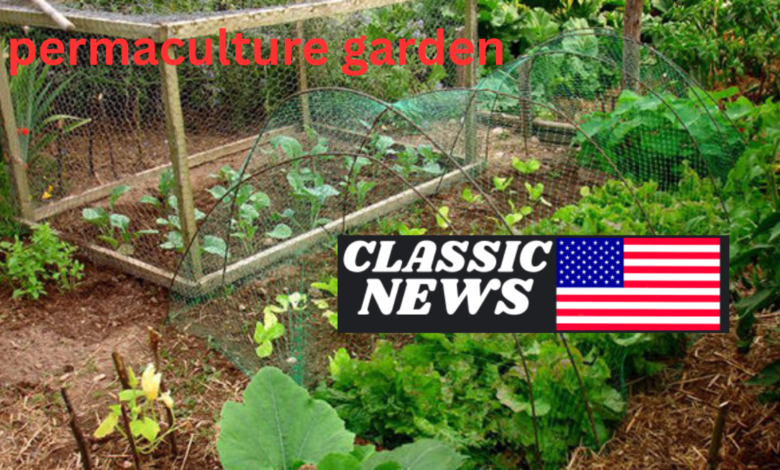Permaculture Garden: Designing a Sustainable and Productive Ecosystem

Permaculture gardening is more than just a method of growing plants; it’s a holistic approach to creating sustainable, self-sufficient ecosystems. Rooted in principles of ecological harmony and efficiency, permaculture gardens aim to mimic natural systems, creating productive landscapes that require minimal intervention. In this detailed guide, we will explore the philosophy behind permaculture, the design principles, practical applications, and the benefits of establishing a permaculture garden.
What is Permaculture?

permaculture garden is a design philosophy and system for creating sustainable human habitats by imitating the natural ecosystems found in nature. Coined by Bill Mollison and David Holmgren in the 1970s, the term “permaculture” combines “permanent” and “agriculture,” reflecting the idea of developing agricultural systems that are sustainable over the long term. Unlike traditional farming, which often relies on external inputs and monocultures, permaculture focuses on designing systems that work in harmony with nature.
The core concept of permaculture is to create a balanced, self-sustaining environment where plants, animals, and humans interact in a mutually beneficial way. This approach emphasizes reducing waste, conserving resources, and promoting biodiversity. By following these principles, permaculture gardens can produce food, provide habitat, and support ecological health while minimizing the need for external inputs.
Principles of Permaculture
Permaculture is guided by several key principles that inform its design and implementation:
- Observe and Interact: Understanding the natural environment and how different elements interact is fundamental. This involves observing patterns in nature and how they can be applied to the garden.
- Catch and Store Energy: Design systems that capture and store resources, such as water and sunlight, to use them efficiently. Techniques like rainwater harvesting and solar energy collection are examples.
- Obtain a Yield: Ensure that the garden produces a tangible benefit, whether it’s food, fuel, or other resources. This principle emphasizes the practical outcomes of permaculture design.
- Apply Self-Regulation and Accept Feedback: Be adaptable and responsive to changes and feedback from the environment. This involves adjusting practices based on what is learned through observation and experience.
- Use and Value Renewable Resources: Focus on using resources that can be replenished naturally, such as composting organic waste and using renewable energy sources.
- Design from Patterns to Details: Start with a broad design framework and refine it based on specific details and needs. This approach ensures that the garden functions effectively as a whole system.
These principles serve as the foundation for creating a permaculture garden, guiding decisions about design, plant selection, and management.
Benefits of Permaculture Gardening
Permaculture gardening offers numerous benefits, including:
- Environmental Sustainability: By mimicking natural ecosystems, permaculture gardens help conserve resources, reduce waste, and promote biodiversity.
- Increased Resilience: Permaculture systems are designed to be resilient and adaptable to changing conditions, reducing vulnerability to pests, diseases, and climate fluctuations.
- Reduced Labor and Input Costs: Once established, permaculture gardens often require less maintenance and fewer external inputs compared to traditional gardens. This can lead to lower costs and less labor over time.
- Enhanced Ecosystem Services: Permaculture gardens provide habitat for wildlife, improve soil health, and contribute to the overall health of the local ecosystem.
These benefits make permaculture gardening an attractive option for those seeking a more sustainable and harmonious approach to gardening.
Site Analysis and Assessment
Before starting a permaculture garden, it’s essential to conduct a thorough site analysis and assessment. This process involves evaluating the physical characteristics of the site and understanding how these factors will influence the design. Key aspects to consider include:
- Climate and Weather: Analyze local climate patterns, including temperature, precipitation, and seasonal variations. This information will help determine suitable plant species and design features that can withstand local weather conditions.
- Soil Quality: Assess soil type, texture, and fertility. Conduct soil tests to determine pH levels and nutrient content. Soil quality affects plant growth and influences decisions about soil amendments and planting strategies.
- Water Resources: Identify sources of water, such as rainfall, groundwater, or nearby bodies of water. Consider how water will be captured, stored, and distributed throughout the garden.
- Sunlight Exposure: Observe patterns of sunlight and shade throughout the day. This information is crucial for placing plants and designing garden features that maximize sunlight exposure.
Conducting a detailed site analysis helps to create a design that is tailored to the specific conditions of the garden area.
Creating a Permaculture Design Plan
With site analysis complete, the next step is to create a permaculture design plan. This plan should integrate the principles of permaculture and address the specific needs and characteristics of the site. Key elements to include in the design plan are:
- Zones and Sectors: Divide the garden into zones based on how frequently different areas will be used and how much attention they will require. For example, high-maintenance plants might be placed closer to the house (Zone 1), while less frequently visited areas (Zone 4 or 5) can be used for wild or less-managed elements.
- Design Patterns: Incorporate natural patterns and processes, such as water flow and wind direction, into the design. Use these patterns to guide the placement of elements and optimize their functionality.
- Plant Selection: Choose plants that are well-suited to the local climate and soil conditions. Incorporate a mix of annuals, perennials, and ground covers to create a diverse and resilient plant community.
- Water Management: Design systems for capturing and storing water, such as rain barrels or swales. Plan for irrigation needs and ensure that water is distributed efficiently throughout the garden.
A well-thought-out design plan is essential for creating a functional and successful permaculture garden.
Implementing the Design
Once the design plan is in place, the implementation phase begins. This involves preparing the site, planting, and setting up the various systems and features outlined in the design. Key steps in this process include:
- Site Preparation: Clear and prepare the site for planting. This may involve removing existing vegetation, amending the soil, and installing infrastructure such as paths or raised beds.
- Planting and Installation: Follow the design plan to plant selected species and install features such as water catchment systems, compost bins, and trellises. Ensure that plants are spaced appropriately and placed in suitable locations based on their light and water requirements.
- Ongoing Maintenance: Monitor the garden regularly and make adjustments as needed. This may involve managing pests, adjusting irrigation, and adding compost or other soil amendments.
Successful implementation requires attention to detail and a commitment to maintaining the garden over time.
Soil Health and Management
Soil is a fundamental component of any permaculture garden. Healthy soil supports plant growth and contributes to the overall health of the garden ecosystem. Key practices for maintaining soil health include:
- Composting: Use composting to recycle organic matter and improve soil fertility. Composting not only provides valuable nutrients but also enhances soil structure and moisture retention.
- Mulching: Apply mulch to conserve soil moisture, suppress weeds, and improve soil fertility. Organic mulches, such as straw or wood chips, decompose over time and contribute to soil health.
- Cover Cropping: Plant cover crops during the off-season to protect and enrich the soil. Cover crops prevent erosion, fix nitrogen, and improve soil structure.
Maintaining healthy soil is essential for a thriving permaculture garden and contributes to the garden’s overall resilience.
Water Management Techniques
Efficient water management is a cornerstone of permaculture gardening. Implementing effective water management techniques ensures that water resources are used wisely and supports the health of the garden. Key techniques include:
- Rainwater Harvesting: Collect and store rainwater using barrels, cisterns, or other storage systems. Rainwater harvesting reduces reliance on municipal water sources and provides a sustainable water supply for the garden.
- Swales and Contour Beds: Design swales and contour beds to capture and direct water flow. These features help prevent erosion, reduce runoff, and increase water infiltration into the soil.
- Drip Irrigation: Use drip irrigation systems to deliver water directly to plant roots. This method minimizes water waste and ensures that plants receive consistent moisture.
Effective water management is crucial for maintaining a productive and sustainable permaculture garden.
Plant Selection and Diversity
Choosing the right plants and promoting plant diversity are important aspects of permaculture gardening. A diverse plant community supports ecosystem health and resilience. Key considerations for plant selection and diversity include:
- Native Plants: Incorporate native plants that are adapted to the local climate and soil conditions. Native plants often require less maintenance and provide habitat for local wildlife.
- Companion Planting: Use companion planting techniques to enhance plant growth and deter pests. Certain plant combinations can improve nutrient uptake, repel harmful insects, and support beneficial organisms.
- Seasonal Planting: Plan for year-round productivity by selecting plants that provide harvests throughout different seasons. This approach helps maintain a steady supply of food and reduces periods of low productivity.
Promoting plant diversity and selecting suitable species contribute to the overall success and sustainability of the permaculture garden.
- Practical Applications of Permaculture Gardening
Urban Permaculture Gardens
Permaculture gardening is not limited to rural or large spaces; it can also be adapted to urban environments. Urban permaculture gardens offer a range of benefits, including:
- Space Optimization: In urban areas with limited space, vertical gardening, container gardening, and rooftop gardens can maximize growing areas and make efficient use of available space.


